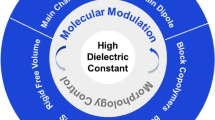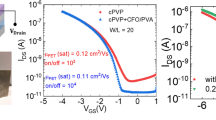Abstract
In this study, organic field-effect transistors (OFETs) were fabricated using plasticized poly(methyl methacrylate) (PMMA) as the gate dielectric and copper phthalocyanine (CuPc) as the active layer. Propylene carbonate (PC) was used as a plasticizer material. The dielectric properties of the plasticized PMMA were investigated in detail and the OFET parameters were examined. The effective capacitance (Ci) of plasticized PMMA was measured as ~ 500 nF cm−2 (at 100 Hz), which is almost 70 times higher than that of pure PMMA. This increase in effective capacitance led to significant improvements in various key parameters of the fabricated OFETs. High hole field-effect mobility values (0.81 cm2 V−1 s−1), low threshold voltages (~ ±0.1 V), and low operating voltages (0 to ±0.8 V) were achieved by using the plasticized PMMA dielectric. The temperature dependence of the fabricated OFETs was also investigated, and the activation energy of CuPc was estimated as 29.3 meV. The plasticized OFETs demonstrated excellent stability over 3600 measurement cycles carried out in an ambient atmosphere. This demonstrated stability of the fabricated OFETs reinforces the practical feasibility of this material combination strategy, positioning it as a key advancement in the field of solution-processable gate dielectrics.





Similar content being viewed by others
Data Availability
The datasets generated during and/or analyzed during the current study are available from the corresponding author on reasonable request.
References
K. Liu, B. Ouyang, X. Guo, Y. Guo, and Y. Liu, Advances in flexible organic field-effect transistors and their applications for flexible electronics. npj Flex Electron. 6, 1 (2022).
C. Risko and J.L. Brédas, Organic semiconductors: healing contact. Nat. Mater. 12, 1084–1085 (2013).
S. Wang, M. Kappl, I. Liebewirth, M. Müller, K. Kirchhoff, W. Pisula, and K. Müllen, Organic field-effect transistors based on highly ordered single polymer fibers. Adv. Mater. 24, 417–420 (2011).
A. Nawaz, L. Merces, L.M. Ferro, P. Sonar, and C.C. Bufon, Impact of planar and vertical organic field-effect transistors on flexible electronics. Adv. Matter. 35(11), 2204804 (2023).
B.L. Hu, K. Zhang, C. An, W. Pisula, and M. Baumgarten, Thiadiazoloquinoxaline-fused naphthalenediimides for N-type organic field-effect transistors (OFETs). Org. Lett. 19(23), 6300–6303 (2017).
T. Lei, Y. Cao, Y. Fan, C.J. Liu, S.C. Yuan, and J. Pei, High-performance air-stable organic field-effect transistors: Isoindigo-based conjugated polymers. J. Am. Chem. Soc. 133(16), 6099–6101 (2011).
Q. Wang, E.J. Juarez-Perez, S. Jiang, L. Qiu, L.K. Ono, T. Sasaki, X. Wang, Y. Shi, Y. Zheng, and Y. Qi, Spin-coated crystalline molecular monolayers for performance enhancement in organic field-effect transistors. J. Phys. Chem. Lett. 9(6), 1318–1323 (2018).
K. Kim, J. Bae, S.H. Noh, J. Jang, S.H. Kim, and C.E. Park, Direct writing and aligning of small-molecule organic semiconductor crystals via “dragging mode” electrohydrodynamic jet printing for flexible organic field-effect transistor arrays. J. Phys. Chem. Lett. 8(22), 5492–5500 (2017).
X. Ren, Z. Lu, X. Zhang, S. Grigorian, W. Deng, and J. Jie, Low-voltage organic field-effect transistors: challenges, progress, and prospects. ACS Mater. Lett. 4(8), 1531–1546 (2022).
P. Kumar, V.N. Mishra, and R. Prakash, Ultralow-voltage eco-friendly water-induced LiOx/AlOx bilayer dielectric-based OFET. IEEE Trans. Electron Devices 70, 4345–4350 (2023).
G. Konwar, P. Saxena, V. Raghuwanshi, S. Rahi, and S.P. Tiwari, Multifunctional flexible organic transistors with a high-k/natural protein bilayer gate dielectric for circuit and sensing applications. ACS Appl. Electron. Mater. 4(5), 2525–2533 (2022).
X. Wang, H. Wang, Y. Li, Z. Shi, D. Yan, and Z. Cui, Polymer/silicon nanoparticle hybrid layer as high-k dielectrics in organic thin-film transistors. J. Phys. Chem. C 122(21), 11214–11221 (2018).
M. Halik, H. Klauk, U. Zschieschang, G. Schmid, C. Dehm, M. Schütz, S. Malsch, F. Effenberger, M. Brunnbauer, and F. Stellacci, Low-voltage organic transistors with an amorphous molecular gate dielectric. Nature 431(7011), 963–966 (2004).
M.H. Yoon, A. Facchetti, and T.J. Marks, σ-π molecular dielectric multilayers for low-voltage organic thin-film transistors. PNAS 102, 4678 (2005).
C. Kim, Z. Wang, H.-J. Choi, Y.-G. Ha, A. Facchetti, and T.J. Marks, Printable cross-linked polymer blend dielectrics. Design strategies, synthesis, microstructures, and electrical properties, with organic field-effect transistors as testbeds. J. Am. Chem. Soc. 130(21), 6867–6878 (2008).
Y. Xia, W. Zhang, M. Ha, J.H. Cho, M.J. Renn, C.H. Kim, and C.D. Frisbie, Printed Sub-2 V gel-electrolyte-gated polymer transistors and circuits. Adv. Funct. Mater. 20(4), 587–594 (2010).
L. Herlogsson, Y.Y. Noh, N. Zhao, X. Crispin, H. Sirringhaus, and M. Berggren, Downscaling of organic field-effect transistors with a polyelectrolyte gate insulator. Adv. Mater. 20(24), 4708–4713 (2008).
L. Zhang, H. Wang, Y. Zhao, Y. Guo, W. Hu, G. Yu, and Y. Liu, Substrate-free ultra-flexible organic field-effect transistors and five-stage ring oscillators. Adv. Mater. 25(38), 5455–5460 (2013).
B. Gburek and V. Wagner, Influence of the semiconductor thickness on the charge carrier mobility in P3HT Organic field-effect transistors in top-gate architecture on flexible substrates. Org. Electron. 11(5), 814–819 (2010).
W.L. Leong, N. Mathews, B. Tan, S. Vaidyanathan, F. Dötz, and S. Mhaisalkar, Solution processed non-volatile top-gate polymer field-effect transistors. J. Mater. Chem. 21(25), 8971 (2011).
J.H. Choi, Y. Gu, K. Hong, W. Xie, C.D. Frisbie, and T.P. Lodge, High capacitance, photo-patternable ion gel gate insulators compatible with vapor deposition of metal gate electrodes. ACS Appl. Mater. Interfaces 6(21), 19275–19281 (2014).
J.H. Cho, J. Lee, Y. Xia, B. Kim, Y. He, M.J. Renn, T.P. Lodge, and C.D. Frisbie, Printable ion-gel gate dielectrics for low-voltage polymer thin-film transistors on plastic. Nat. Mater. 7(11), 900–906 (2008).
K.H. Lee, S. Zhang, T.P. Lodge, and C.D. Frisbie, Electrical impedance of spin-coatable ion gel films. J. Phys. Chem. B 115(13), 3315–3321 (2011).
M.J. Panzer and C.D. Frisbie, High charge carrier densities and conductance maxima in single-crystal organic field-effect transistors with a polymer electrolyte gate dielectric. Appl. Phys. Lett. 20, 88 (2006).
H. Shimotani, H. Asanuma, J. Takeya, and Y. Iwasa, Electrolyte-gated charge accumulation in organic single crystals. Appl. Phys. Lett. 20, 89 (2006).
J. Seo, S. Nam, J. Jeong, C. Lee, H. Kim, and Y. Kim, Liquid crystal-gated-organic field-effect transistors with in-plane drain–source–gate electrode structure. ACS Appl. Mater. Interfaces 7(1), 504–510 (2015).
Y. Wang, X. Huang, T. Li, L. Li, X. Guo, and P. Jiang, Polymer-based gate dielectrics for organic field-effect transistors. Chem. Mater. 31(7), 2212–2240 (2019).
Y.Y. Noh and H. Sirringhaus, Ultra-thin polymer gate dielectrics for top-gate polymer field-effect transistors. Org. Elecetron. 10(1), 174–180 (2009).
N.B. Ukah, S.P. Senanayak, D. Adil, G. Knotts, J. Granstrom, K.S. Narayan, and S. Guha, Enhanced mobility and environmental stability in all organic field-effect transistors: the role of high dipole moment solvent. J. Polym. Sci. Part B Polym. Phys. 51(21), 1533–1542 (2013).
M.A.K.L. Dissanayake, R. Jayathissa, V.A. Seneviratne, C.A. Thotawatthage, G.K.R. Senadeera, and B.E. Mellander, Polymethylmethacrylate (PMMA) based quasi-solid electrolyte with binary iodide salt for efficiency enhancement in TiO2 based dye sensitized solar cells. Solid State Ionics 265, 85–91 (2014).
Z.A. Kösemen, A. Kösemen, S. Öztürk, B. Canımkurbey, and Y. Yerli, High mobility and low operation voltage organic field effect transistors by using polymer-gel dielectric and molecular doping. Mater. Sci. Semicond. Process. 66, 207–211 (2017).
A. Kösemen, High-performance organic field-effect transistors fabricated with high-k composite polymer gel dielectrics. J. Electron. Mater. 48, 7819–7826 (2019).
I.G. Korodi, D. Lehmann, M. Hietschold, and D.R.T. Zahn, Improving the mobility of CuPc OFETs by varying the preparation conditions. Appl. Phys. A 111(3), 767–773 (2013).
L. Qin, W. Liu, J. Su, Z. Yang, Z. Liang, X. Li, P. Luan, D.-K. Wang, Z.-H. Lu, and Q. Zhu, Influence of volatile organic compound adsorption on the characteristics of organic field-effect transistors and rules for gas-sensing measurements. Langmuir 39(44), 15756–15765 (2023).
S.M. Sze, Physics of Semiconductor Devices, 2nd ed., (New York: Willey, 1981).
Y.N. Novikov, A.A. Gismatulin, B. Hallac, Y. Roizin, and V.A. Gritsenko, Bipolar charge transport and contact phenomena in Al2O3. Thin Solid Films 781, 140004 (2023).
K.-L. Tung, K.-T. Lu, R.-C. Ruaan, and J.-Y. Lai, Molecular dynamics study of the effect of solvent types on the dynamic properties of polymer chains in solution. Desalination 192, 1–3 (2006).
G. Knotts, A. Bhaumik, K. Ghosh, and S. Guha, Enhanced performance of ferroelectric-based all organic capacitors and transistors through choice of solvent. Appl. Phys. Lett. 104, 233301 (2014).
N.B. Ukah, J. Granstrom, R.R. Gari Sanganna, G.M. King, and S. Guha, Low-operating voltage and stable organic field-effect transistors with poly (methyl methacrylate) gate dielectric solution deposited from a high dipole moment solvent. Appl. Phys. Lett. 99, 243302 (2011).
M. Kraus, Charge Carrier Transport in Organic Field-Effect Devices Based on Copper-Phthalocyanine, University of Augsburg, (2011).
M.J. Panzer and C.D. Frisbie, High carrier density and metallic conductivity in poly(3-hexylthiophene) achieved by electrostatic charge injection. Adv. Funct. Mater. 16(8), 1051–1056 (2006).
T. Minari, T. Nemoto, and S. Isoda, Temperature and electric-field dependence of the mobility of a single-grain pentacene field-effect transistor. J. Appl. Phys. 99(3), 034506 (2006).
M. Abbas, A. Pivrikas, E. Arici, N. Tekin, M. Ullah, H. Sitter, and N.S. Sariciftci, Temperature dependent charge transport in organic field-effect transistors with the variation of both carrier concentration and electric field. J. Phys. D Appl. Phys. 46, 455105 (2013).
M. Schwarze, C. Gaul, R. Scholz, F. Bussolotti, A. Hofacker, K.S. Schellhammer, B. Nell, B.D. Naab, Z. Bao, D. Spoltore, K. Vandewal, J. Widmer, S. Kera, N. Ueno, F. Ortmann, and K. Leo, Molecular parameters responsible for thermally activated transport in doped organic semiconductors. Nat. Mater. 18(3), 242–248 (2019).
J. Gao, K. Asadi, J.B. Xu, and J. An, Controlling of the surface energy of the gate dielectric in organic field-effect transistors by polymer blend. Appl. Phys. Lett. 94(9), 093302 (2009).
S. Mallik, S. P. Verma, S. Saha, R. Nayak, P. K. Guha, D. K. Goswami,. in IEEE International Conference on Emerging Electronics (ICEE) Conferenece Proceedings 1–5 (2022)
H.F. Haneef, A.M. Zeidell, and O.D. Jurchescu, Charge carrier traps in organic semiconductors: a review on the underlying physics and impact on electronic devices. J. Mater. Chem. C 8(3), 759–787 (2020).
T. Minari, T. Nemoto, S. Isoda, Temperature and electric-field dependence of the mobility of a single-grain pentacene field-effect transistor. J. Appl. Phys. 99(3) (2006).
S.F. Nelson, Y.Y. Lin, D.J. Gundlach, and T.N. Jackson, Temperature-independent transport in high-mobility pentacene transistors. J. Appl. Phys. 72(15), 1854–1856 (1998).
Author information
Authors and Affiliations
Contributions
All authors contributed to the study conception and design. Material preparation, data collection, and analysis were performed by ŞF, OÖ, RK, and SÖ. The manuscript was written by AK. All authors read and approved the final version of the manuscript.
Corresponding author
Ethics declarations
Conflict of interest
The authors declare that they have no known competing financial interests or personal relationships that could have appeared to influence the work reported in this paper.
Additional information
Publisher's Note
Springer Nature remains neutral with regard to jurisdictional claims in published maps and institutional affiliations.
Supplementary Information
Below is the link to the electronic supplementary material.
Rights and permissions
Springer Nature or its licensor (e.g. a society or other partner) holds exclusive rights to this article under a publishing agreement with the author(s) or other rightsholder(s); author self-archiving of the accepted manuscript version of this article is solely governed by the terms of such publishing agreement and applicable law.
About this article
Cite this article
Findik, Ş., Öztürk, S., Örnek, O. et al. Detailed Investigation of Plasticized PMMA Dielectric for Improved Performance of Organic Field-Effect Transistors. J. Electron. Mater. 53, 2554–2561 (2024). https://doi.org/10.1007/s11664-024-10974-5
Received:
Accepted:
Published:
Issue Date:
DOI: https://doi.org/10.1007/s11664-024-10974-5




